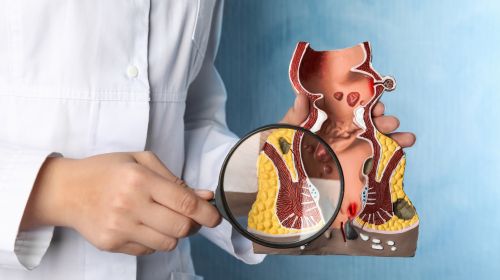Skin tags are lentil to chestnut-sized flaps of skin on the outer edge of the anal. They usually do not cause any symptoms and do not require treatment unless they cause recurring inflammation or make anal hygiene difficult.
- © Getty Images/AnnaStills (icon image)
Brief overview: skin tags (anal folds)
Definition: Skin tags are harmless flaps of skin on the edge of the anus, which are usually soft and vary in size.
Cause: No cause can be identified for most skin tags. In some cases, they are associated with another condition, such as hemorrhoids or anal fissures. They can also occur after operations in the anal region.
Symptoms: In most cases skin tags do not cause any symptoms. However, if anal hygiene is very difficult, itching and weeping inflammation can occur.
Diagnosis: A visual diagnosis or proctological examination is usually sufficient for the diagnosis of skin tags, sometimes a colonoscopy is also carried out.
Treatment: Ointments, creams and sitz baths often help with mild inflammation. In severe cases, the skin tags are surgically removed.
Article content at a glance:
What are skin tags?
Skin tags (anal folds) are skin-colored folds or lobules that can form around the edge of the anus. They are usually soft in consistency, but they can also swell and become hard knots. The size of skin tags ranges from skin folds of a few millimeters to skin flaps several centimeters in size. They occur singly or in groups, in some cases forming a ring that encloses the entire anus. They got their name from the French word for fig (Marisque), because they remind you of their appearance.
Skin tags appear at any age, but are observed more frequently with age. In women, this frequent occurrence (due to hormonal changes during pregnancy) begins at the age of 20, in men at the age of 40. Overall, around 75 percent of women and 70 percent of men are affected by skin tags at some point in their lives.
Skin tags: causes and risk factors
In most cases, skin tags appear for no apparent reason, in which case they are referred to as “primary skin tags”. A distinction must be made between the so-called “secondary skin tags”, which are associated with a disease:
In the case of chronic anal fissures, a skin thickening forms on the outer edge of the fissure over time, which is referred to as the “outpost fold”.
Skin tags sometimes remain after a perianal vein thrombosis has healed.
Skin tags also form in some cases after operations (e.g. for haemorrhoids or anal fistulas).
The chronic inflammatory bowel disease Crohn’s disease can affect the anal area and contribute to the formation of skin tags.
What are the symptoms of skin tags?
In most cases skin tags do not cause any symptoms. Usually they are more of a cosmetic and/or hygienic problem. If the skin tags become too large, anal hygiene can become more difficult: Remaining stool residue or excessive cleaning can lead to inflammatory changes in the anal skin.
These are manifested by the following symptoms:
- itching
- Burn
- Pains
- oozing
- skin redness
- Spotting on your underwear or toilet paper
Diagnosis: This is how skin tags are identified
For the diagnosis and treatment of skin tags, the family doctor’s practice is the first point of contact; if necessary, a doctor from the proctology department will be referred from there. A detailed inspection of the anal area is usually sufficient to secure the diagnosis: For this purpose, the anal region is examined with the eyes and, if necessary, a finger for the typical folds of the anal skin or skin flaps.
Since skin tags are sometimes associated with certain diseases of the rectum, this area is also sometimes examined with the help of a proctoscope to detect, for example, hemorrhoids or fissures.
Treatment: How are skin tags treated?
As long as skin tags do not cause any symptoms, they do not require therapy. As soon as they become inflamed, itchy or weeping, the following measures are recommended:
- Thorough but gentle cleaning with clear water
- anti-inflammatory creams, ointments or sitz baths (with chamomile or oak bark)
- Zinc ointment can relieve symptoms, but should not be used over a long period of time.
If there are recurring inflammations or problems with anal hygiene, the skin tags are removed in a minor operation. Depending on the size and number of skin tags, the operation is performed under local, general or spinal anaesthesia. Doctors do not sew up the remaining wound, but it heals on its own within two to four weeks.
Course and prognosis after skin tag surgery
If the wound is showered with clear water twice a day after the procedure, it usually heals without any problems. Sometimes there is minor secondary bleeding or bruising of the skin on the anus, which disappears again within a few days. Painkillers are prescribed for the pain, and after one to two weeks you should be able to work again.
Prevention: How can skin tags be prevented?
Since the cause of skin tags is unknown in most cases, they cannot really be prevented. What can be prevented, however, are fissures, anal vein thrombosis and haemorrhoids, the result of which is often the development of skin tags. All three diseases are aggravated by hard stool, constipation and straining during a bowel movement – a high-fiber diet and adequate fluid intake can have a preventive effect here.


